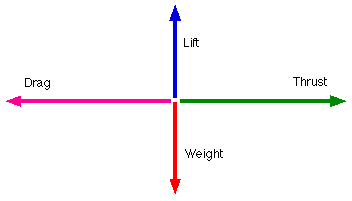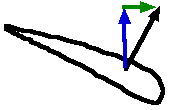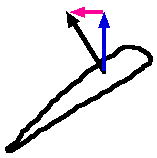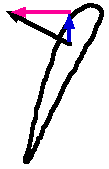Bird Flight Basics
A very much simplified description of the physics of
flight
In order to achieve controlled, flight four forces must
be balanced in a controllable
way.

Bernoulli's Principle- For any fluid, the of speed
of the particles in the fluid is
inversely related to the pressure the particles exert
perpendicular to the flow of the fluid.
In other words, air pressure drops as a function of increased
speed. This can be created
by moving air caused by differential heat and cooling
of the atmosphere (wind), or by
moving a body through air from generated thrust.
The effect is the same either way.
An airfoil is a cross-sectional shape that produces differential
perpendicular pressures
as a consequence of its shape. At the top of the
foil air is compressed and speeded up,
reducing downward perpendicular pressure compared with
the upward pressure
under the wing.

Since upward air pressure is greater than the downward
pressure, the net perpendicular
force is in the upward direction creating lift.
If this lift is greater than the weight of
the bird, the bird is pushed up by the air.

Again, all that is required is moving air. In a
stiff breeze no mechanical thrust force (flapping)
may be necessary, but in still air flapping is needed.
Thrust can be obtained by redirecting some
of the force generated by air flow over the foil.
If the wing is tilted, the perpendicular force
produced by the airfoil is no longer directed upward.
Tipping the front edge of the wing downward
tips the perpendicular force forward. This can
be broken up in components that are upward and
forward creating both lift and thrust. As long
as the lift component is greater than the weight the
bird will be pushed up and if the redirected thrust force
is greater than drag the bird will be pushed
forward. There are limits to how much thrust can
be generated so at low wind speeds or for flight
in directions other than into the wind, additional thrust
must be generated. In an airplane, additional
thrust is generated by mounting a rotating perpendicular
wing on the aircraft. A birds propellers
are mounted at the tips of the wings.

Tipping the forward edge of the wing up converts perpendicular
force into lift and drag. This
allows for breaking.


A birds wing is more than a simple airfoil, however.
Tip the wing back or forward enough
and it is possible to create and equilibrium between
weight and lift, thrust and drag. Each flight
feather (and especially the primaries) is aerodynamic.
This allows a bird to fine tune the
components of lift and thrust against weight and drag
with remarkable precision. By modulating
the air flow over the components of the wing, birds are
able to hover, kite, soar and do other
amazing feats of aerobatics. Much of this depends
on the size, shape and structure of the wings.
Seabirds depend a great deal on a steady wind and have
wings adapted to gliding flight without much
flapping. Soaring raptors using the fingerlike
projection of their primaries to play the subtleties
of changing air currents. Most passerines have
a compromise design that allows for manueverability
and distance flight.
And then there are hummingbirds.....
Find a mistake? Let
me know.